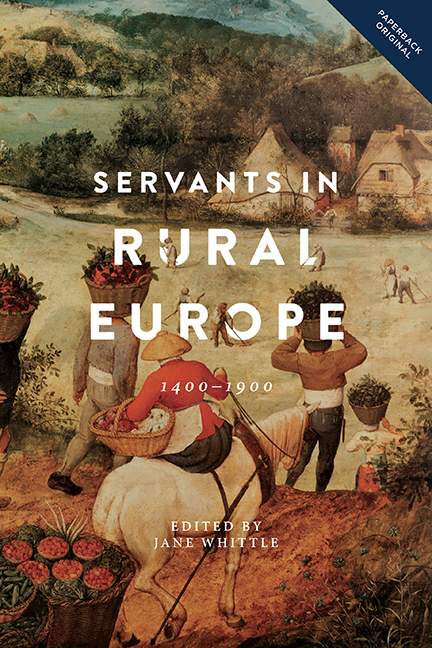Book contents
- Frontmatter
- Contents
- List of Figures
- List of Tables
- Note on Terminology
- List of Contributors
- Introduction: Servants in the Economy and Society of Rural Europe
- 1 The Employment of Servants in Fifteenth- and Sixteenth-Century Coastal Flanders: A Case Study of Scueringhe Farm near Bruges
- 2 The Institution of Service in Rural Flanders in the Sixteenth Century: A Regional Perspective
- 3 A Different Pattern of Employment: Servants in Rural England c.1500–1660
- 4 Female Service and the Village Community in South-West England 1550–1650: The Labour Laws Reconsidered
- 5 Life-Cycle Servant and Servant for Life: Work and Prospects in Rural Sweden c.1670–1730
- 6 Servants in Rural Norway c.1650–1800
- 7 Rural Servants in Eighteenth-Century Münsterland, North- Western Germany: Households, Families and Servants in the Countryside
- 8 Rural Servants in Eastern France 1700–1872: Change and Continuity Over Two Centuries
- 9 The Servant Institution During the Swedish Agrarian Revolution: The Political Economy of Subservience
- 10 Farm Service and Hiring Practices in Mid-Nineteenth-Century England: The Doncaster Region in the West Riding of Yorkshire
- 11 Dutch Live-In Farm Servants in the Long Nineteenth Century: The Decline of the Life-Cycle Service System for the Rural Lower Class
- 12 Rural Life-Cycle Service: Established Interpretations and New (Surprising) Data – The Italian Case in Comparative Perspective (Sixteenth to Twentieth Centuries)
- Select Bibliography
- Index
- People, Markets, Goods: Economies and Societies in History
Introduction: Servants in the Economy and Society of Rural Europe
Published online by Cambridge University Press: 18 April 2018
- Frontmatter
- Contents
- List of Figures
- List of Tables
- Note on Terminology
- List of Contributors
- Introduction: Servants in the Economy and Society of Rural Europe
- 1 The Employment of Servants in Fifteenth- and Sixteenth-Century Coastal Flanders: A Case Study of Scueringhe Farm near Bruges
- 2 The Institution of Service in Rural Flanders in the Sixteenth Century: A Regional Perspective
- 3 A Different Pattern of Employment: Servants in Rural England c.1500–1660
- 4 Female Service and the Village Community in South-West England 1550–1650: The Labour Laws Reconsidered
- 5 Life-Cycle Servant and Servant for Life: Work and Prospects in Rural Sweden c.1670–1730
- 6 Servants in Rural Norway c.1650–1800
- 7 Rural Servants in Eighteenth-Century Münsterland, North- Western Germany: Households, Families and Servants in the Countryside
- 8 Rural Servants in Eastern France 1700–1872: Change and Continuity Over Two Centuries
- 9 The Servant Institution During the Swedish Agrarian Revolution: The Political Economy of Subservience
- 10 Farm Service and Hiring Practices in Mid-Nineteenth-Century England: The Doncaster Region in the West Riding of Yorkshire
- 11 Dutch Live-In Farm Servants in the Long Nineteenth Century: The Decline of the Life-Cycle Service System for the Rural Lower Class
- 12 Rural Life-Cycle Service: Established Interpretations and New (Surprising) Data – The Italian Case in Comparative Perspective (Sixteenth to Twentieth Centuries)
- Select Bibliography
- Index
- People, Markets, Goods: Economies and Societies in History
Summary
Servants were paid workers who lived within the home of their employer, and who received board and lodging as well as a cash wage. They were employed for longer terms, typically several months to a year at a time rather than by the day or task. Both men and women worked as servants, and most servants were young, unmarried people. In terms of days worked, throughout the early modern period servants were the dominant form of wage labour in many European societies, particularly in farming households. For instance, one recent estimate for eighteenth-century England, suggests that there were 1.7 servants for every day labourer in the population. Early-twentieth-century histories of service tended to view the institution through a nineteenthcentury lens, and were largely concerned with domestic servants undertaking housework in middle-class, urban, and wealthy households. It was not until the research of Peter Laslett and John Hajnal was published from the mid-1960s onwards, that historians began to understand the ubiquity of servants in early modern society across large areas of northern and western Europe, and consider the wider implications of service for economic, social and demographic structures. Early modern Europe was an overwhelmingly rural society: before 1800 at least 85 per cent of the population lived outside of large towns. The great majority of people, including servants, lived and worked in households that had some involvement in farming. Yet the literature on servants continues to be dominated by studies of urban and domestic servants. To date, there is only one monograph on rural servants, Ann Kussmaul's Servants in Husbandry in Early Modern England (1981), and no book-length study that compares rural service in different European countries. This volume aims to redress this imbalance.
Servants are important to our understanding of the society and economy of the past for a number of reasons. First, servants were an integral element of what Laslett describes as ‘the family in the western tradition’, and Hajnal ‘the north-west European simple household system’, now commonly referred to as ‘the European marriage pattern’ or EMP. This demographic system was characterized by the dominance of nuclear families (or ‘simple families’), relatively late marriage for both women and men, the setting up of a new household at marriage, and the circulation of young people between households as servants before marriage.
- Type
- Chapter
- Information
- Servants in Rural Europe1400–1900, pp. 1 - 18Publisher: Boydell & BrewerPrint publication year: 2017



